Current as of: June 30, 2025 - 18:52
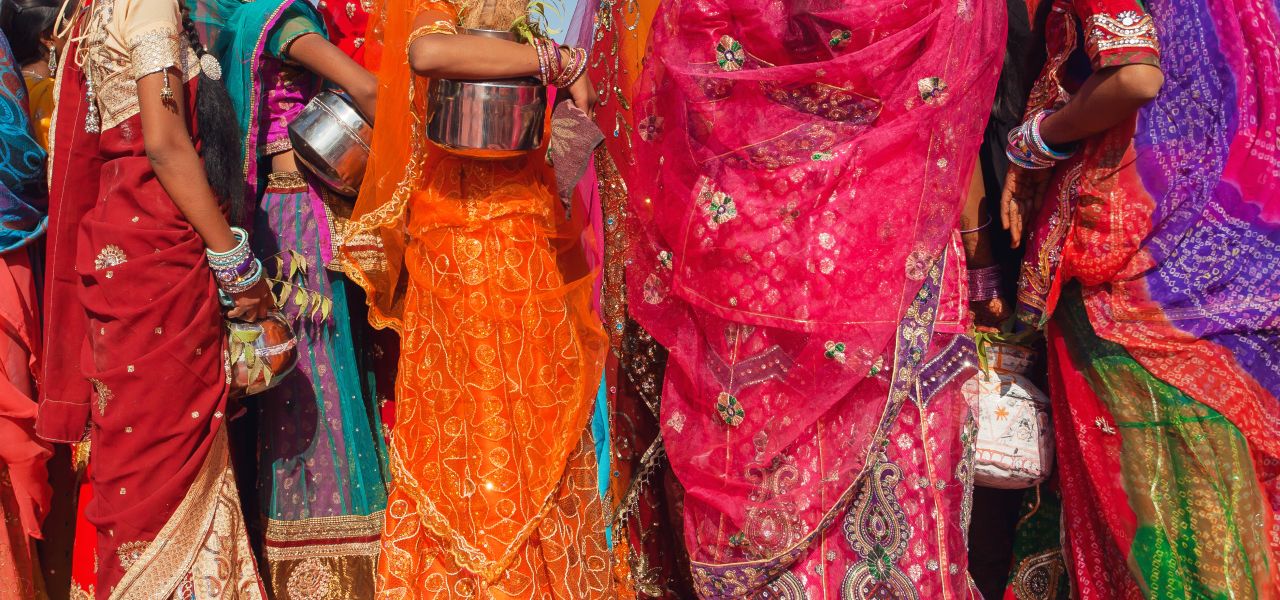
Colours of Rajasthan Trip Notes
- Ways to Travel: Guided Group
- Destination: India
- Programmes: Culture
-
Activity Level:
2 out of 7 - Easy & Moderate
- 13 Days: Land Only
- Ages: 16+
- Trip Code: AIK
- Carbon Footprint: 23kg CO2e
Trip Overview
Discover the domain of the maharajas, exploring regal residences, seeing the Taj Mahal and searching for tigers
Immerse yourself in Rajasthan, known as the Land of Kings for its countless palaces, forts and monuments to warriors past. On this culture-packed adventure, we visit the imposing forts of Jodhpur and Jaipur, which bear testament to the battles that once raged here, visit the Taj Mahal at sunrise, and search Ranthambore National Park for another regal resident: the elusive Bengal tiger.
If you want to travel in 2026, see our revised and extended itinerary here: Colours of Rajasthan (2026). Alternatively, we have special Pushkar Festival departures in both 2025 and 2026.
At a Glance
- Accommodation: 12 Classic nights (hotels)
- Travel by air-conditioned private bus
- Group normally 4 to 16, plus leader. Minimum age: 16
- Holi, Diwali and Pushkar festivals departures available
Highlights
- Explore the majestic state of Rajasthan with a small group and expert tour leader
- See the unforgettable Taj Mahal at sunrise, the most beautiful time to visit
- Maximize your chances of spotting a tiger in Ranthambore National Park with two game drives
- Discover the lesser-known Bundi, a fairytale town on the Aravali foothills
- Explore the lakeside city of Udaipur, nicknamed the Venice of the East
Is This Trip for You?
This trip is rated Activity Level 2 (Easy & Moderate). For more information on our trip gradings, visit the Activity Level Guidelines page. If you have any queries about the difficulty of the trip, please contact us.
Pace: This is a fast-paced cultural trip, jam-packed with the highlights of Rajasthan. It is not overly demanding, but some days can be busy and long, particularly where travelling is combined with sightseeing.
Journeys: The roads are generally pretty good, but traffic and/or road damage after the monsoon can sometimes slow us down. We travel mainly on comparatively quiet roads for at least half the journey. Longer distances are covered by private bus and should take around six to seven hours; however, delays are possible and journey times can increase. This trip does involve a lot of time on the road; however, this gives you the perfect opportunity to see the diversity of one of India’s most colourful states.
Weather: It can be quite hot and dusty (except December to February) and the bustle of the Indian cities can be tiring.
Monuments: The Archaeological Survey of India (ASI) is responsible for the conservation of many monuments in India, including the Taj Mahal, and very occasionally this may mean that work is taking place at sites visited on this trip. The ASI schedule is never published so it is not possible to forewarn when work is taking place.
Holi and Diwali festivals: Some departures coincide with the festivals of Holi and Diwali. These can be quite local celebrations within communities and families and are not necessarily marked to the same extent throughout the country. We seek opportunities to see the festivities; however, we cannot guarantee what may or may not be going on in the area visited during the trip.
Pushkar Festival: Some departures are in Pushkar during the fair. These have a slightly amended itinerary. You have two nights in Pushkar (one night replacing a stay in Jodhpur). See the 2025 itinerary here and the 2026 itinerary here.
Group
Our Indian team of leaders has proved very popular with their incredible knowledge, passion and hospitality adding greatly to the experience. There is no better way to experience Indian culture than letting an Indian guide show you around their country.
Adult min age: 16
Min group size: 4
Max group size: 16
Itinerary
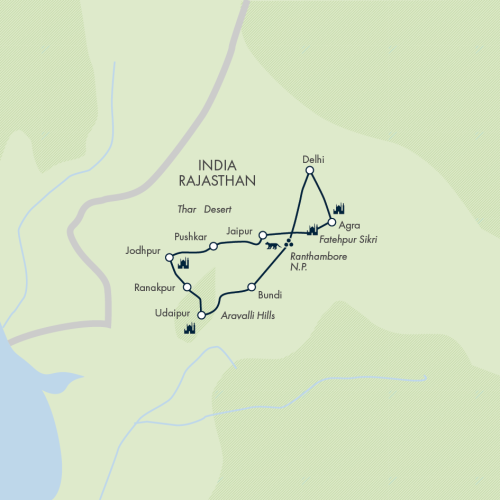
Land Only
- Start City: Delhi
- End City: Delhi
Land Only Itinerary
Flights usually depart London in the evening.
The adventure begins in Delhi. There is a welcome briefing in the evening – the time and location will be posted in the hotel lobby. The rest of the day has been left free, allowing you time to settle into the trip.
Accommodation: Bloom Hotel CR Park (or similar)
Visit the walled city of Old Delhi this morning. It’s crowded, full of activities and still influenced by the great Mughals who once ruled from the ramparts of the majestic Red Fort. Navigating the city, we visit the 17th-century Jama Mosque, the largest mosque in India; Rajghat, a memorial to Mahatma Gandhi; India Gate; and vast colonial buildings. In the afternoon, we transfer (approximately six hours) to Ranthambore National Park.
Accommodation: Raj Palace Resort (or similar)
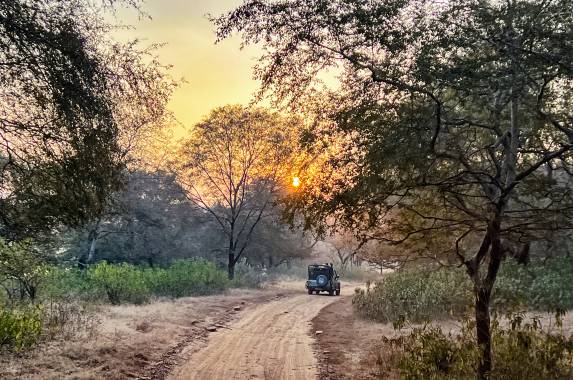
Today we take two game drives in Ranthambore National Park. The reserve was declared a wildlife sanctuary in 1957 and became part of Project Tiger in 1974. After initial success, poaching has drastically reduced the tiger population. However, Ranthambore is still considered one of the best places to spot wild tigers and many of our groups over the last few years have seen the elusive predator. Ranthambore is also home to a great variety of other wildlife, including several species of monkey, deer, crocodile and birdlife.
During the game drives, each vehicle is joined by a Forest Guard, a requirement by the local authorities. The Forest Guards are part of a national park initiative to generate employment for the nearby villages. They are skilled spotters and trackers so, though their English is sometimes very limited, they greatly improve the experience.
Accommodation: Raj Palace Resort (or similar)
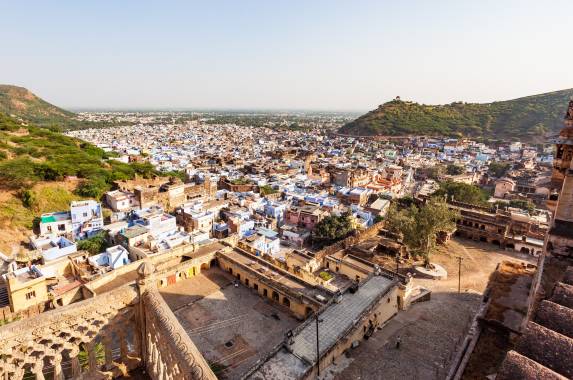
Leave Ranthambore and drive (approximately four hours) to Bundi, a delightful town on the Aravali foothills. It is best known for its palaces and the beautifully decorated stepwells that were used to collect water during the monsoon centuries ago. Visit Bundi Fort in the afternoon, one of the most beautiful palaces in India and home to outstanding miniature paintings portraying the history of the palace and its royal family. The fort is high on a hill overlooking Bundi and its Krishna blue stonewashed houses.
Accommodation: Ishwari Niwas Hotel (or similar)
Set off on our five-hour (145mi/235km) journey to the lakeside city of Udaipur. Known as the Pearl of Rajasthan, the City of Sunrise and Venice of the East, Udaipur is a beautiful place regarded by both Indians and visitors as the most romantic city in India.
Accommodation: Paras Mahal Hotel (or similar)
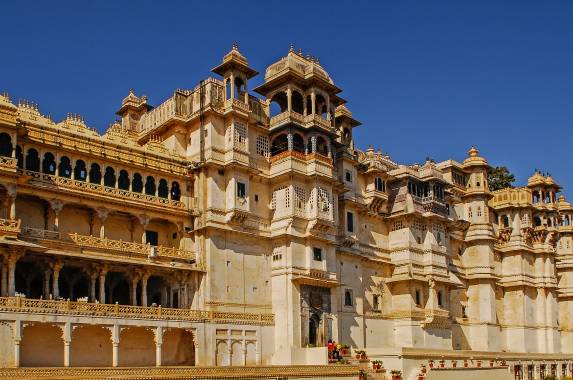
On the east side of Lake Pichola, the main palace commands an unsurpassed view across the shimmering lake to the dusty Aravalli Hills.
The lake has two islands, each with a palace to rival that on the mainland. Jag Mandir and Jag Nivas (the latter is now the Lake Palace Hotel) rise out of their own reflections in the lake waters. Udaipur is surrounded by a massive bastion with five gates and dominating the town is the City Palace of the Maharana. The sumptuous apartments are decorated with multi-coloured mosaics, elaborate mirror work and inlaid tiles; half of these can be visited as the current Maharaja still occupies the rest of the palace. Spend the morning visiting the City Palace and Jagdish Temple, with a huge black-stone image of Jagannath, an aspect of Lord Vishnu. If time allows, it may be possible to visit the gardens of Gulab Bag or take a boat trip on the lake. The afternoon is free to enjoy this evocative city.
Accommodation: Paras Mahal Hotel (or similar)
Taking the scenic road out of Udaipur, we head to Jodhpur. It’s a seven-hour drive, but to break up the journey we visit the 15th-century Jain temple at Ranakpur. The main temple, beautifully carved from marble, is dedicated to Adinath and has 29 halls supported by 1,444 pillars, each delicately carved with a different design.
Jodhpur was founded by the Rajput chief Roa Jodha and was formerly the capital of the state of Marwar. The city is surrounded by a wall almost 6mi (10km) in circumference and is dominated by the massive fort that stands on a rocky hill commanding the surrounding desert.
Accommodation: Shree Ram International Hotel (or similar)
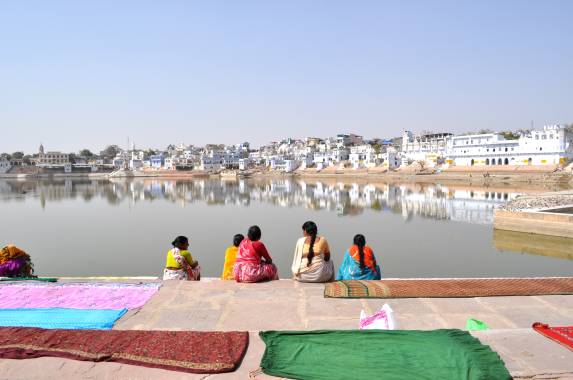
First thing in the morning, we visit the Meherangarh Fort for a great view of the blue houses, painted to distinguish them as those of Brahmins. The fort itself looks massive from the outside but inside there is an impressive collection of finely carved sandstone screens and lattice windows, and the palaces themselves are very finely decorated. We then head to Pushkar, pilgrimage town and home to the annual Pushkar Fair. Steeped in mysticism and surrounded by the desert, this little town is a holy site on the fringes of a lake and a great place to relax and soak up the atmosphere. Today’s total drive time is approximately six hours.
Accommodation: Hotel Dera Masuda (or similar)
Enjoy sightseeing this morning. In the centre of town is the holy Pushkar Lake surrounded by several temples, including a Bramha temple said to be the only temple in the world dedicated to this deity. A dip in the lake waters and worship at the Bramha temple ensure salvation. In the afternoon, we drive (approximately three hours) to Jaipur.
Holi Festival Departure (14 March 2025): For the Holi Festival departure, you are given the opportunity in Pushkar to join the celebrations at your hotel and purchase the traditional white kurta outfit to look the part and avoid getting your own clothes covered in the coloured powders.
Accommodation: Hotel 7 Apple (or similar)
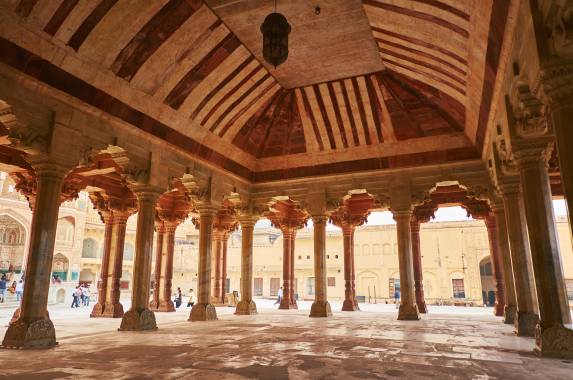
Enjoy a day of sightseeing in the Pink City of Jaipur, one of the most attractive cities in India. Rajah Jai Singh abandoned his nearby fortress and palace at Amber in 1727 and laid out a planned city of broad avenues, built of sandstone and painted pink at a later stage.
We start as the sun rises, heading out for a dawn walking tour led by a local guide as the Pink City wakes. See the local people start their day and the rituals that take place in early morning markets and small temples. We visit different chowkris (blocks) within the walled city, with the chance to interact with different artisans.
Returning to the hotel for breakfast and some time to refresh, we head out again mid-morning for a city tour led by a local guide. Visit the highlights, including one of the most intriguing sights in India, the observatory of Jai Singh. This is an assembly of immense astronomical instruments. We also see the Hawa Mahal, or Palace of the Winds, and the splendid Amber Palace, rising above a lake outside the city.
Accommodation: Hotel 7 Apple
Transfer to Agra (approximately 4hr 30min), visiting Fatehpur Sikri, the deserted royal city of Emperor Akbar, on the way. This impressive and well-preserved citadel became his capital in 1571, after the blessing of a local Moslem holy man correctly predicted the birth of a longed-for son, his successor Jehangir. The mosque, designed to hold 10,000 worshippers, the palaces, residences and halls of audience, are constructed of decorative red sandstone. But this magnificence only lasted 14 years; Akbar left Fatehpur Sikri in 1584 to secure his outlying territories, leaving this city much as we see it today.
This afternoon, we visit the imposing Red Fort of Akbar, whose mighty sandstone walls enclose the beautiful white-marble Pearl Mosque and the palaces, halls, courtyards and fountains of his sons and successors, Jehangir and Shah Jahan.
Accommodation: Avalon Palms (or similar)

Wake early to visit the Taj Mahal at sunrise, when the white-marble exterior is illuminated by the soft early light, the crowds are smaller and the birds chatter among themselves. After admiring it from the outside, we head inside, with a chance to explore the beautiful inner chambers and mausoleum, while our tour leader shares the history of this New World Wonder.
Following breakfast, we begin our journey (approximately four to five hours) back to Delhi, stopping on the outskirts of Agra to visit and support Wildlife SOS. Their work is dedicated to rescuing and caring for sloth bears and elephants. At the Agra Elephant Conservation and Care Centre, we meet an education officer to learn about their vital work and commitment to rehabilitating abused elephants and advocating for their conservation through public awareness campaigns. We tour the centre and see some of the rescued elephants and hear their stories.
After the visit, we resume our drive to Delhi and check into our hotel. It’s your last night together so the tour leader can help to arrange a group dinner.
Accommodation: Bloom Hotel CR Park (or similar)
The adventure ends after breakfast and we begin our return journeys home. Alternatively, if you’d like to spend a bit more time exploring this magnificent city, speak to your sales representative about extending your stay.
The tour ends after breakfast. We take a morning transfer to Delhi International Airport for the flight to our onward destination.
Accommodation
A selection of hotels
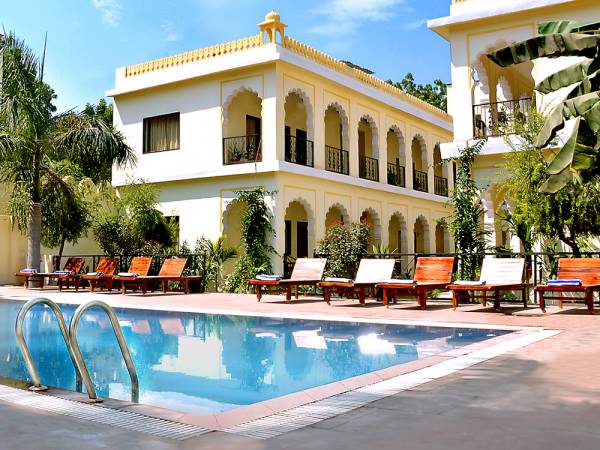
On this adventure through Rajasthan, we spend 12 nights in hotels. The accommodations typically used can be found on the day-to-day itinerary. However, below are a few of the notable hotels on this trip.
Delhi: Bloom Hotel CR Park (night 1 and 12)

In the affluent Chittaranjan Park neighborhood, Bloom Hotel CR Park provides a seamless stay in lively Delhi. Strategically situated in the south of the city, it has convenient access to the bustling business districts and cultural attractions.
Bundi: Ishwari Niwas Hotel (night 4)
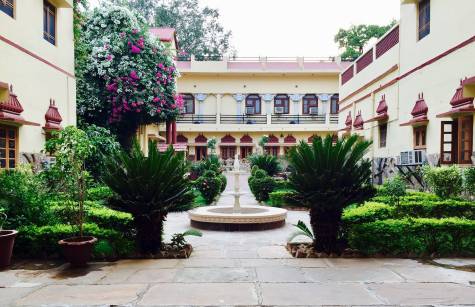
Stay in a haveli (mansion) turned heritage hotel. It provides 24 rooms with traditional Bundi décor around an open courtyard with seating. There’s also a multi-cuisine restaurant, which specialises in Rajasthani dishes. The 100-year-old building, constructed during the reign of Maharao Raja Ishwari Singh, is close to the Bundi Palace and other historic attractions.
Udaipur: Paras Mahal Hotel (nights 5-6)

Relax in green gardens overlooking the Aravalli Hills when you stay at the Paras Mahal. Find further chilled moments at the Urvashi Bar, an ideal gathering spot for the group, or with a splash in the pool. It’s also close to the main attractions in Udaipur: the City Palace and Lake Pichola.
Jodhpur: Shree Ram International Hotel (night 7)
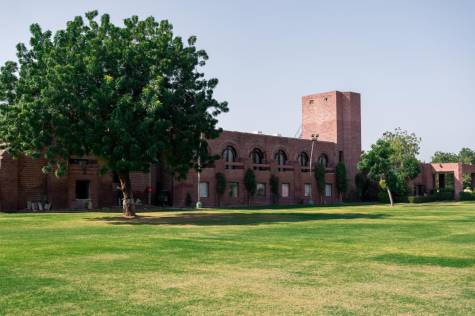
There’s plenty to recommend the Shree Ram, most notably a sprawling green garden with plenty of space to wander and relax. There’s also an outdoor pool for a quick dip plus a café-bar stocked with wines, cocktails and more. Elsewhere, there’s The Basil restaurant, serving a variety of cuisines.
Worth knowing
- Hotels in India usually do not have heating as there are really only a couple of months in the year when the weather can get rather cold. You can request more blankets or the hotel may be able to provide a standing heater for your room. Please talk to your tour leader if you need help in this matter.
Single supplement from 420 €
Food & Drink
All breakfasts are included on this trip.
Where meals are not supplied, our tour leaders always encourage people to try local restaurants and street-food vendors − allow at least 1,400-2,400 Indian rupees (approximately US$20-US$35) per day for lunch and dinner. In Jaipur, Udaipur and Delhi, you can even see how food and drink, such as samosa (mashed potato snacks), jalebe (Indian doughnuts) and lassi (yoghurt drink), are made. In most towns, there is a good selection of restaurants and a choice between Indian and Western-style food. If you are vegetarian, India is probably one of the best destinations to visit. Tea and soft drinks are very cheap. A (large) bottle of beer is approximately 300-400 rupees (approximately US$4-US$5). Mineral water is available in the bus in large containers. Please bring a water bottle with you to refill. Please note, service in restaurants can be quite slow.
Transport
We use a private air-conditioned bus for our journey.
Game drives in Ranthambore National Park: Tiger spotting is from a large open truck called a canter that seats a maximum of 22. The canters are licenced and usually allocated by the National Park authorities; while our local contacts do their best to secure the most appropriate vehicles, we are unable to guarantee vehicle standards, maintenance or that seatbelts are fitted across all vehicles.
Weather & Seasonality
During October/November and February/March/April, the days are normally warm to hot and nights cool or mild. Humidity is very low with little or no rain. Evenings in Delhi can be surprisingly cool. It gets very cold in the early mornings and evenings in December and January and warm clothes are essential. Fog is also a real possibility during this period. Please note, night-time temperatures in Delhi can be very cold and only a little above freezing in December and January.
Joining Instructions
Key information
Start hotel: Bloom Hotel CR Park, A, 2 & 3, Chittranjan Park Rd, Block A, Chittaranjan Park, New Delhi, Delhi 110019, India
Phone: +91 11 4122 5666
Recommended arrival time: You can arrive at any time today. There will be a welcome briefing in the evening, but if you miss it the leader will update you separately.
Airport: Indira Gandhi International Airport (DEL)
Getting to the start hotel
The start hotel is approximately 30 minutes’ drive from the airport. Exodus provides free arrival transfers to the start hotel from the airport for all customers. If you would like further information on joining this trip, please speak to your sales representative.
Catching your return flight
Exodus provides free departure transfers for all customers to Indira Gandhi International Airport (DEL) from the end hotel. Please ensure you provide your flight details at least two weeks prior to arrival to secure your airport transfer.
Please note, unless specified otherwise, the transfers will be to the start (or pre-tour) hotel and from the end (or post-tour) hotel and will be on the date on which the tour starts/ends; transfers to other hotels in the same city and/or on different dates may attract an extra charge. Transfers should be booked with your sales representative at least two weeks before the tour starts.
Full joining instructions including local emergency numbers will be sent to you as part of our Final Joining Instructions. If you do not receive these at least a week before departure, or require them earlier please contact our office or your travel agent.
Location start: Delhi
Location end: Delhi
What To Take
Essential Equipment
- Sunhat
- Sunglasses
- Sunscreen
- Light casual clothing
- Warm sweater/fleece
- Torch (flashlight)
- Water bottle
- Sports or walking shoes
- Sandals/flip-flops
- Anti-bacterial hand gel
- Insect repellent
- Small personal first-aid kit
- Additional warm base layer (for winter departures)
- Scarf (for winter departures)
- Gloves (for winter departures)
- Small backpack for the day
For some monument or temple visits, clothing should cover shoulders and be on or below the knee, with exception of the Jain Temple at Ranakpur where men and women must be fully covered: trousers (pants)/long skirts and long sleeves/shawl). In general, women should consider dressing conservatively to avoid unwanted attention and not to cause offence.
For Holi Festival departures, it might be a good idea to take some old clothes you don’t mind throwing away afterwards. You can also purchase the traditional white kurta outfit to look the part and avoid getting your own clothes covered in the coloured powders.
Optional Equipment
- Light waterproof
- Earplugs
- Money belt
- Travel pillow
Face mask: air pollution is high in Delhi during November (but also occasionally at the end of October and beginning of December)
Prohibited items to travel with in India
- The Indian government has banned e-cigarettes and related products. You can’t buy e-cigarettes in India or bring them into the country. Please ensure you do not pack these in your luggage.
- Satellite communications devices, for example (but not exclusively) Garmin inReach or any other brand GPS tracking device, are illegal in India without a license. Please do not bring them with you.
Practical Information
Visa
India
To avoid possible problems at immigration, make sure your passport is valid for a minimum of 180 days at the time of entry into India.
Travellers from the UK, US, CA and EU normally need a visa to enter India. Please note, visa requirements often change and it is your responsibility to obtain any required visas for this trip. Therefore, we recommend that you check with the nearest embassy or consulate of your chosen destination(s), including any countries you may be transiting or transferring through.
Some local governments provide guidance on what visas their citizens need. To help, we’ve gathered a selection of useful links below.
• Australia: www.smartraveller.gov.au/destinations/asia/india
• Canada: www.travel.gc.ca/destinations/india
• United Kingdom: www.gov.uk/foreign-travel-advice/india/entry-requirements
• USA: www.travel.state.gov/content/travel/en/international-travel/International-Travel-Country-Information-Pages/India.html
Travellers eligible for an e-visa, which includes those from the UK, US, CA and EU, can apply at www.indianvisaonline.gov.in/evisa/tvoa.html.
For more information on applying for your Indian Visa, including details required for your start hotel and local reference contacts, please click on this link: Indian Visa Information
Vaccinations and Health
India
You require a yellow fever vaccination certificate if arriving from a country with risk of yellow fever transmission. Proof of a polio vaccination may also be required by some visitors. Please confirm all requirements and recommendations with your doctor or travel clinic.
You may also want to consider vaccinations for tetanus, hepatitis A, typhoid, cholera, hepatitis B, Japanese encephalitis, rabies and tuberculosis. The risk of malaria is slight, but you may wish to consult your doctor or travel clinic for further advice.
Additionally, dengue fever and chikungunya are known risks in India. Both are tropical viral diseases spread by daytime biting mosquitoes. There is currently no vaccine or prophylaxis available for either, and therefore the best form of prevention is to avoid being bitten. We recommend you take the usual precautions to avoid mosquito bites.
Some of our India trips spend time at altitude. In regions over approximately 6,560ft (2,000m), there is little risk of mosquito-borne diseases. For trips above 9,840ft (3,000m), there is a risk of being affected by acute mountain sickness. Our itineraries are designed to enable everyone to acclimatise to these altitudes, but you should be aware that it is still possible for you to be affected. Please see the Trip Notes for further information.
The risk of malaria on this trip is slight, but you may wish to consult your GP or travel health clinic for further advice.
Middle East Respiratory Syndrome: There is evidence that Middle East Respiratory Syndrome coronavirus (MERS) is spread by contact with camels. This trip may include the option of a camel ride, or it spends time close to camels, which is undertaken at your own risk; we suggest that you visit the Travel Health Pro website which includes information about the virus.
Local Time
India's time zone: Asia/Kolkata (UTC +05:30)
Electricity
India's electricity: Plug types C (two round pins), D (three round pins) and M (three round pins) – 230V, 50Hz

Money
India's currency: Indian rupee (INR). Please note, it is illegal to import or export rupees. Do not accept torn or very dirty Indian banknotes from banks or in change as they will almost certainly not be accepted as legal tender in India. You can normally change money back from rupees into US dollars or British pounds at the departure airport, but you must produce an exchange receipt showing that you changed money in India.
ATM Availability
ATMs are widely available (Visa and Mastercard are best). However, you should not rely on these 100 percent of the time, so please take some cash too. Please inform your bank before departure that you are travelling to India and carry the relevant telephone number with you in case they put a block on your card. You can pay with credit cards in bigger shops all over India.
Money change facilities are available on arrival at Delhi international airport although better exchange rates may be available in the city. You can change US dollars and British pounds in cash in Delhi and in the other main cities on this itinerary.
Extra Expenses & Spending Money
Many sites now charge a small fee for video cameras and you should allow another 650 rupees (approximately US$8) for these. Also allow at least 650 rupees per day for personal expenditure, such as soft drinks. Shopping opportunities throughout this tour are endless and we suggest you take money for souvenirs.
India has very good opportunities for shopping, especially for locally made goods, and during your trip it is highly likely your local guides will take you to emporiums as well as workshops where these goods are made. Many people find this a great opportunity to buy local handicrafts, silk and carpets. Guides often assume visitors want to shop, it is very much part of the culture, but if you do not wish to go, please make this clear to your local guide at the time.
Optional excursions
Sometimes it is possible to do the following:
- Bollywood movie: Approximately 170-300 rupees (US$2-US$4) per person
- Cooking class: Approximately 2,200-2,500 rupees (US$25-US$30) per person
- Afternoon boat ride in Udaipur: Approximately 500 rupees (US$6) per person
- Sunset boat ride in Udaipur: Approximately 800 rupees (US$10) per person
Tipping
Tipping is part of the culture in India and is usually expected. Tipping can often be an awkward affair, especially when in an unfamiliar country where you are not sure when or how much to tip. As such, your tour leader will offer to arrange and look after a group tipping kitty, which will be used to tip hotel staff, local sightseeing guides, bus drivers as well as any other support staff used throughout your trip. Your leader will suggest how much to contribute, depending on group size, but it is usually in the region of 2,200-2,500 rupees (approximately US$35-US$40) per person based on the maximum group size of 16 passengers. For smaller groups, the leader may ask to collect more than the suggested amount relative to the group size, this is to assist with covering the standard tipping expectations for things like the local guides, drivers, and hotel staff (which, are generally fixed amounts no matter the group size).
For departures that travel during Holi Festival (14 March 2025) your tour leader will look to arrange some activities for you to enjoy and join in with the festivities. There will be a small supplement between 600-1,600 rupees (approximately US$7-US$20) per person which is usually deducted from the kitty. Price depends upon the location and festival inclusions for Holi celebration.
At any time during the trip, your leader will happily show you an account of how the kitty is being distributed. Please note, for smaller groups the leader may have to collect more than the above amount.
Tipping of leaders is not included in the kitty and is at your own discretion. If you wish to show your appreciation, a tip around 410-500 rupees (US$5-US$6) per person per day would be appreciated.
Sustainability and Impact
As a certified B Corp, we’re on a mission to improve our social and environmental impact across all our adventures.
We do this through our innovative Thriving Nature, Thriving People plan.
This ‘nature positive’ approach is designed to help nature and communities thrive in harmony though practical solutions, such as reducing carbon and waste on our trips, supporting conservation projects through the Exodus Adventure Travels Foundation, and rewilding 100 square metres for every Exodus traveller.
Important Information
Your safe participation
When booking this trip, you should be confident in your ability to participate in all activities described in these Trip Notes. If you have any doubt about your suitability, please call us and ask to speak to one of the experts on this itinerary.
Although our leaders are well trained to deal with different capabilities, if they have any concerns about someone’s ability to safely take part in an activity, or their impact on other people’s enjoyment, we authorise them to take necessary action which, in some circumstances, may involve asking someone to miss that activity.
By booking this trip you agree to our Booking Conditions which clearly state that our leaders have the authority to do this. In these rare instances we will ensure anyone sitting out is safely provided for and offered alternative options where possible. Refunds will not be provided for activities missed and customers may be liable for additional costs incurred.
Seatbelts
All vehicles used by us should be equipped with working seatbelts, except where approved by us based on the vehicle type or journey. Wherever seatbelts are available, we require our customers to use them for their own safety, even where it may not be a legal requirement.
How to Book
- Check availability: Go online to check availability, or contact us by phone or email.
- Secure your place: You can provisionally hold a place on this trip, usually for between three and seven days.
- Complete your booking and payment
When you’re ready to book, go to our website for online bookings, book over the phone or you can complete a booking form (available online or on request by calling us). We accept all major credit and debit cards.
After booking
You will receive your booking confirmation letter and invoice, which includes extra information and guidance about your travel arrangements.
Full joining instructions, including local emergency numbers and details of how to reach the start point, will be sent to you approximately two to three weeks prior to departure. If you do not receive these at least a week before departure, or require them earlier, please contact our office or your travel agent.
Trip Note validity
These Trip Notes are valid from the “Current as” date on page one. They will occasionally be updated after booking and before departure; if there are any updates that significantly impact the inclusions or itinerary, customers will be written to separately. They will also receive a link to the most up-to-date Trip Notes with their Final Joining Instructions before travelling.
The information in these Trip Notes is given in good faith. Where differences exist between the Trip Notes and our current brochure or website, the Trip Notes supersede the brochure and website. All holidays can be subject to unexpected changes; to enjoy them you should be prepared to be flexible where necessary. Occasionally, it may not be possible to follow the itinerary as planned. This may be for a variety of reasons – climatic, political, physical or other. In these circumstances we will make the best-possible alternative arrangements that maintain the integrity of the original itinerary.
Licensing
Exodus is fully licensed and bonded as a tour operator. We hold Air Traffic Organisers Licence (ATOL) number 2582, issued and bonded with the Civil Aviation Authority (CAA). We are also bonded to the International Air Transport Association (IATA) and we are members of the Federation of Tour Operators (FTO) and ABTA – The Travel Association. This means you can book your Exodus holiday with confidence, as all money paid to us for your trip is fully protected.